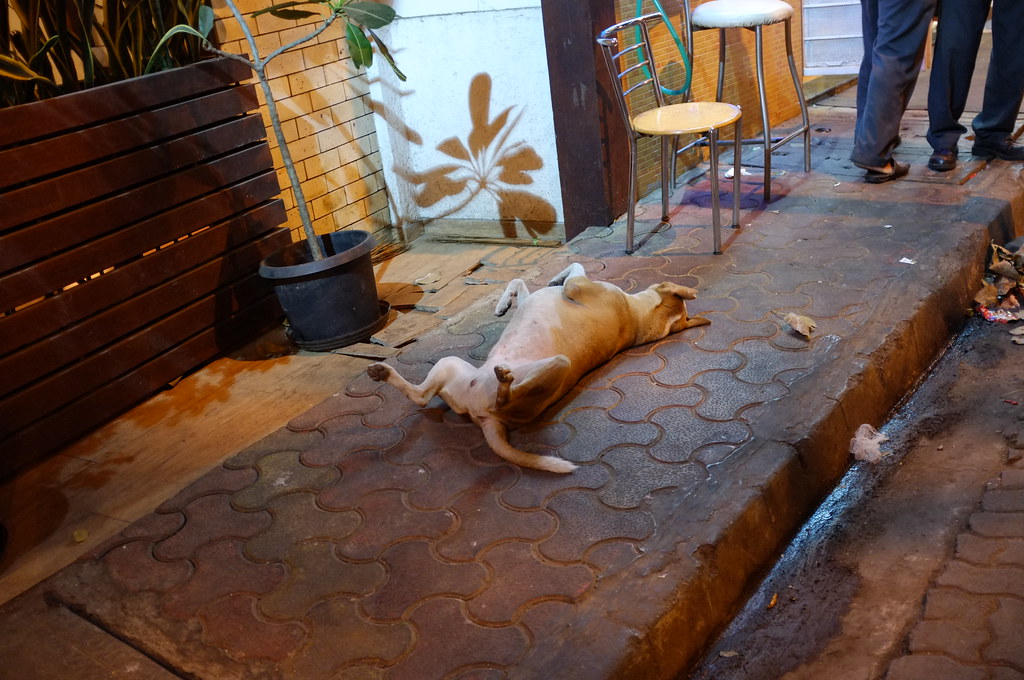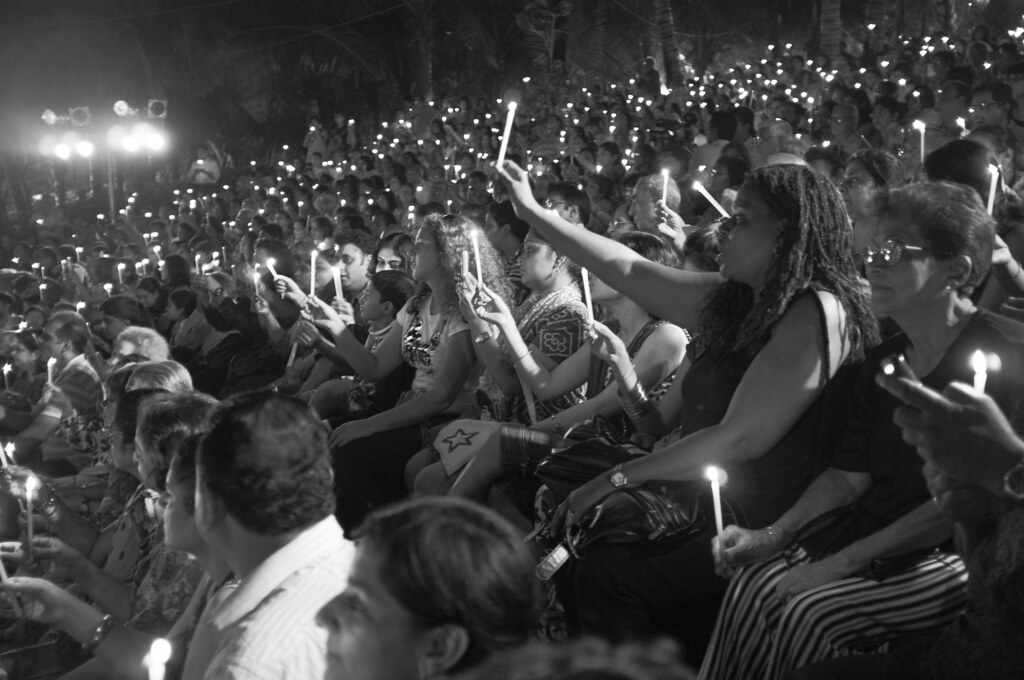The dog woke up a few minutes later…
Category: India
This was about the time Usha Uthup sang “We Are the World”
Remembering 26/11

Today is the third anniversary of the 26/11 Mumbai terrorist attacks which took place in 2008 over the course of 60 hours. It is hard to understate how much this attack has indelibly changed the face of Mumbai: from the military checkpoints and machine-gun pill boxes, to the security theatre which surrounds entering any location which hosts large groups of foreigners, to the increase in negative views (if possible) of Pakistan.
Happy Thanksgiving from Bombay
I didn’t have Turkey, mashed potatoes with gravy, cornbread, any other fixings and didn’t get to spend the day with loved ones. But I am thankful for the last year. And thankful my wife bought me my favorite West Wing episode for iTunes download, Shibboleth. My favorite part is on youtube:
Thumbs Up!
Thumbs Up!, a photo by plemeljr on Flickr.
Cartography Police

On the front page of the Times of India, is the following piece, US state department shows PoK as part of Pakistan:
At a time when incorrect India maps are getting the goat of not just the government but also journalists, there is even more alarming news for India’s strategic community. The official website of US department of state, which handles foreign relations of the country, shows PoK as part of Pakistan, notwithstanding India’s claim over the region.
In the case of India, however, the map differs from the official Indian map in that it completely ignores India’s claim over PoK by not even acknowledging its disputed status.
…
“It shows a distinct pro-Pakistan cartographic tilt that is inconsistent with the UN projection of the entire PoK (including Gilgit-Baltistan) as disputed,” strategic affairs expert Brahma Chellaney said.
The offending map is nary to be found on the State website (but is reprinted above and at the CIA Factbook on India), so it undoubtably has been seen as a diplomatic slight and is being fixed. If you want to learn more about how and what this is all about, check out this abridged Wikipedia list:
- Indo-Pakistani War of 1947 – Pakistan acquires two-fifths of Kashmir, Line of Control established
- Sino-Indian War of 1962 Line of Actual Control established
- Indo-Pakistani War of 1965
- Indo-Pakistani War of 1971 – Bangladesh is formed (Pakistan effectively loses half their population)

The Yoruba say that lines hove power. “This country has become civilized” literally means “This earth has lines upon its face.” Ilàjú in Yoruba means both “Civilization” and face with lined marks. The line on a body is the city, the polis, the civilization.
I can understand, if not completely internalize the sentiment of this article. I don’t want to step into this longstanding 64+ year long argument, especially after a colleague chastised me when I was drawing the map of India and left off the PoK. My colleague yelled, “You left the crown off the top! Are you some kind of Pakistani cartographer?” While it was good natured, the admonishment stayed with me, revealing a topic which is better left not discussed as a foreign visitor.
Note that this isn’t just about lines on a map, even if this week’s Economist has been censored due to showing the disputed area of Kashmir (see also Fantasy frontiers which explains the territorial claims). Rather there are both nationalistic reasons for disputing the borders, but also physical reasons: natural resources. Don’t miss the epic Economist article, Unquenchable thirst, A growing rivalry between India, Pakistan and China over the region’s great rivers may be threatening South Asia’s peace:
The river swirls away, white-crested and silt-laden, racing to the nearby border with Pakistan. But there Baglihar is a source of bitterness. Pakistanis cite it as typical of an intensifying Indian threat to their existence, a conspiracy to divert, withhold or misuse precious water that is rightfully theirs. Officials in Islamabad and diplomats abroad are primed to grumble about it. Pakistan’s most powerful man, the head of the armed forces, General Ashfaq Kayani, cites water to justify his “India-centric” military stance.
Others take it further. “Water is the latest battle cry for jihadis,” says B.G. Verghese, an Indian writer. “They shout that water must flow, or blood must flow.” Lashkar-e-Taiba, a Pakistani terror group, likes to threaten to blow up India’s dams. Last year a Pakistani extremist, Abdur Rehman Makki, told a rally that if India were to “block Pakistan’s waters, we will let loose a river of blood.”
Diwan-i-Khas, Fatehpur Sikri
Fatehpur Sikri is a hill palace outside of Agra, constructed by Akbar. This is the Diwan-i-Khas, or Hall of Private Audience. The central pillar, which has a square base and an octagonal shaft, both carved with bands of geometric and floral designs, further its thirty-six serpentine brackets support a circular platform for Akbar, which is connected to each corner of the building on the first floor, by four stone walkways. It is here that Akbar had representatives of different religions discuss their faiths and gave private audience.
NYC grid everywhere: Mumbai, India

What does the New York City grid look like if we extend it throughout the world? Well, Extend NY helps visualize what those streets look like.
Right now I’m at the intersection of East 74,461 Ave and 94,097th Street. Which subway should I take home?
Random Building, Mumbai
Diwali must be Hindi for Explosives
Diwali is upon us – the Festival of Lights – where large candles are set out in the hallways and picture windows, lights are strung from buildings and small-calibre munitions are exploded throughout the dense metropolis. Instead of the infinite, and unending, sidewalk cricket matches sprinkled throughout the city, matches which make Test Cricket look like temporary vacations, the youth of the neighborhood cluster in an apparent attempt to catch my flat on fire.
 While I do have twelve floors in elevation on them, the amount of airborne explosions is shockingly high. For the last three nights fireworks have rained throughout the neighborhood, attesting to the unending supply of explosives and enthusiasum and the need to banish evil spirits. This confirms my suspicion that India celebrates better, or at least with better endurance than other countries I have visited. Why celebrate one night when you can celebrate five nights in a row?
While I do have twelve floors in elevation on them, the amount of airborne explosions is shockingly high. For the last three nights fireworks have rained throughout the neighborhood, attesting to the unending supply of explosives and enthusiasum and the need to banish evil spirits. This confirms my suspicion that India celebrates better, or at least with better endurance than other countries I have visited. Why celebrate one night when you can celebrate five nights in a row?
At least the view is pretty.
I cannot begrudge the semi-professional firework displays, since after each blast the children of the neighborhood scream and cheer with such enthusiasm, their excitement filtering through the secondary explosions. While I prefer the sharing of sweets and welcoming the grace of Lakshmi and Ganesh to my door who will hopefully shower us with both wealth and auspicious beginnings, I’ll take the sound of children cheering any day.
Happy Diwali!







